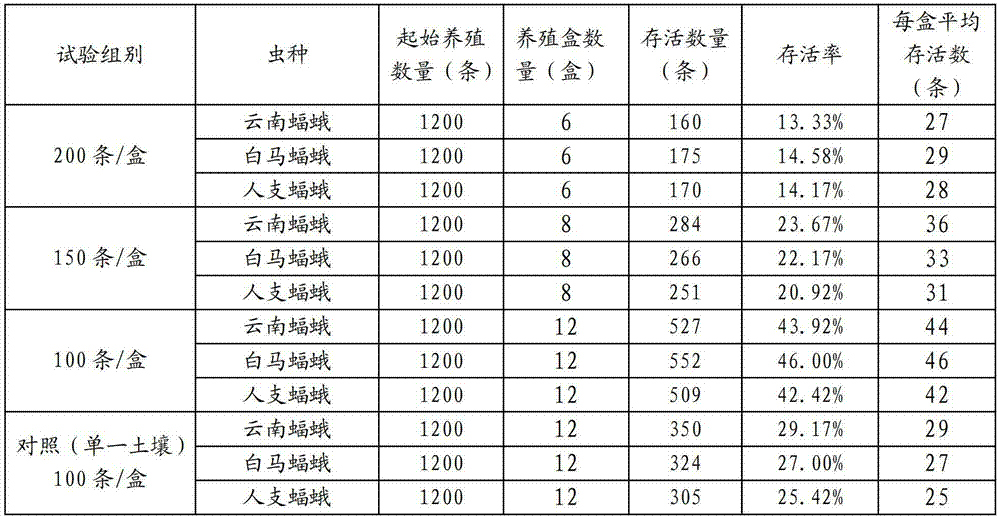Method for culturing hepialus larvae indoors
A breeding method and bat moth technology, applied in the field of insect breeding, can solve the problems of ecological environment damage, low survival rate of bat moth larvae, inconvenient production and life, etc., to avoid easy death, good market application prospects, land resources and space The effect of high utilization
- Summary
- Abstract
- Description
- Claims
- Application Information
AI Technical Summary
Problems solved by technology
Method used
Image
Examples
Embodiment 1
[0061] Investigate the group culture density of mixed culture substrate
[0062] 1. Implementation location
[0063] The residence of the applicant of the present invention in Shangri-La County, Yunnan Province, with an altitude of 3280m.
[0064] 2. Implementation method
[0065] Use the used mixed substrate breeding of the technical scheme step 3 of the present invention, soil and step 5, set 3 kinds of stocking densities such as 200 / box, 150 / box, 100 / box, and set with single soil culture As a control, the feeding density of the control group was 100 / box, and the number of feeding per 1 setting was 1200, and the survival rate was compared when the 6th instar was raised to the end. The rearing insect species were Thitarodes baimaensis, T.renzhiensis and T.yunnanensis. The 2nd instar larvae are obtained through steps 1-3 of the technical solution of the present invention. The raising of 2-6 instars is basically according to step 5 of the patented technical scheme of the pr...
Embodiment 2
[0071] Investigating the feasibility of using mixed substrates for amplified culture is a further verification of Example 1.
[0072] The basic method and insect species are the same as in Example 1, the difference is that the initial breeding quantity of the 2nd instar worms of each insect species is 20000, and only the initial breeding quantity of 100 / box is adopted, and the ratio of the mixed substrate is the same as that of Example 1 . The results of the implementation are 8,752 surviving 6th instar larvae of the Yunnan bat moth, with a survival rate of 43.8%; 9,022 surviving 6th instar larvae of the white horse bat moth, with a survival rate of 45.11%; %.
Embodiment 3
[0074] Investigate the application of full-load culture in the bat moth larva culture room.
[0075] The bat moth larva breeding room is constructed according to the technical solution step (1) of the present invention, and the indoor space has a length of 20m, a width of 6m, and a height of 3.6m. The stacking height of the breeding boxes is 3 meters. After the daily work channel is reserved, the utilization rate of the surface area is 60%. A total of 6,000 breeding boxes can be stacked, and a total of 3 buildings will be built.
[0076]The breeding method is the same as that in Example 2. The initial number of cultured 2nd instars of the yunnanensis, the white horse moth, and the manta moth is 600,000, and the result of the implementation is 253077 surviving 6th instars of the yunnanensis, with a survival rate of 42.2 %; 262,614 surviving bat moths, with a survival rate of 43.8%; 237,079 surviving 6th-instar larvae of the manta moth, with a survival rate of 39.5%. A total of...
PUM
 Login to View More
Login to View More Abstract
Description
Claims
Application Information
 Login to View More
Login to View More - R&D
- Intellectual Property
- Life Sciences
- Materials
- Tech Scout
- Unparalleled Data Quality
- Higher Quality Content
- 60% Fewer Hallucinations
Browse by: Latest US Patents, China's latest patents, Technical Efficacy Thesaurus, Application Domain, Technology Topic, Popular Technical Reports.
© 2025 PatSnap. All rights reserved.Legal|Privacy policy|Modern Slavery Act Transparency Statement|Sitemap|About US| Contact US: help@patsnap.com

